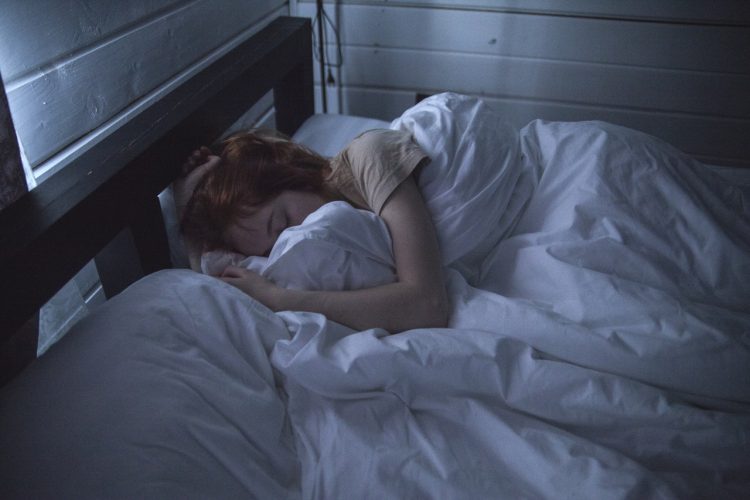From time to time we all have trouble sleeping, and it seems that the more we chase sleep, the more it eludes us. Who hasn’t spent a restless night, unable to sleep before a big test or job interview? The more you repeat to yourself, “I have to get some sleep!” the less sleepy you feel.
If you’re lucky, this sleeplessness hits one night, makes for a miserable following day, and the next night things are back to normal. On the other hand, if this happens to you regularly, whenever you have something important on your mind, you might ask yourself if there isn’t some way to assure a good night’s sleep when you really need it.
Or maybe you’ve been struggling with insomnia for a while now. You’re starting to doze off at red lights when you’re driving. You know you aren’t doing your best at work because you aren’t thinking clearly. You fall asleep in class and wonder if anyone noticed. And everyone close to you says you are miserable to be around.
You start wondering if you should take something to help you sleep, but worry how it will affect you the next day. Maybe you’re cautious about taking a drug that could be habit-forming. Medication could be the answer to your insomnia and certainly, any drastic change in sleep habits should be checked by your doctor to rule out a serious health problem.
But increasing numbers of people are finding that they sleep better with a weighted blanket. Could one help you with your insomnia?
What is Insomnia?
Insomnia is difficulty going to sleep or staying asleep when you have the opportunity to do so. When circumstances allow for sleep but you are still lying awake for hours, are continually waking up during the night, or are waking too early, you have insomnia.
Like many medical conditions, insomnia can be classified as acute or chronic. An acute case lasts for a short time, a night or two, and is more likely to be caused by an outside influence. Receiving bad news or being nervous about the next day could cause you to lose a night or two of sleep. Something like a death in the family might bring on a longer, but still acute, case.
Acute insomnia hits hard but does go away again, at least for awhile. Chronic insomnia is a lingering problem. Officially, it is defined as sleeplessness lasting more than three months and occurring three or more nights a week. In addition, chronic cases are more likely to have an underlying medical cause.
Congestive heart failure, angina, asthma, COPD, tumors, Parkinson’s and Alzheimer’s, can all cause ongoing insomnia. Chronic pain from arthritis, fibromyalgia, neuropathy or back pain can also affect sleep.
Unhealthy sleep habits, jet lag, shift work, certain medications, hormone shifts, and psychological factors from ordinary worry to anxiety, depression, or bipolar disorder can all keep us awake. Sometimes treating the underlying illness or condition will treat insomnia. Other times making lifestyle changes will work well in conjunction with a medical solution.
Whatever the reason for your insomnia, and often there is no obvious reason, there is growing evidence that a weighted blanket might help. In fact, one recent sleep study concluded, “A weighted blanket may aid in reducing insomnia…(and) provide an innovative, non-pharmacological approach and complementary tool to improve sleep quality.”
This study found that insomnia sufferers showed decreased movement during sleep and more prolonged periods of sleep. How are these findings significant?
The Right Kind of Sleep
When you are sleeping, you go through four stages, three non-REM stages (N1, N2, and N3) and finally REM sleep. REM stands for rapid eye movement and is the period of deepest sleep. When we are at this stage, our eyes dart about in conjunction with spurts of increased brain activity.

This is when we dream. As we progress through these four stages, from N1 to REM, we move less with each one, until in REM sleep, our muscles are so unresponsive, we are essentially paralyzed.
This paralysis probably protects us from injuring ourselves while acting out our dreams. One thing is clear when we are deeply asleep, we aren’t moving as much, if at all.
In the aforementioned study of insomnia and weighted blankets, researchers tracked the participants’ movements and found that those with weighted blankets moved less throughout the test period. Moving less indicates that these individuals with insomnia were spending more of their sleep time in N3 and REM sleep, where movement is limited.
This is important especially for someone who struggles with sleep because insomnia tends to affect REM sleep disproportionately.
During the night, we go through these stages several times. Each time we work through the cycle we stay in REM sleep longer than the previous time. Shorter bouts of sleep rob us more of deep sleep than light sleep because we don’t get to the final stage, or aren’t there long before we wake up.
This study also showed that the test subjects with weighted blankets tended to sleep for longer periods at a time. Longer bouts of uninterrupted sleep mean a better chance of getting to a point of deep sleep. But why are these final stages of sleep so important?
Getting enough of the later stages of sleep, N3 and REM is crucial because it is during deep sleep that our bodies and brains are kept healthy. This is the part of sleep that leaves us feeling rejuvenated, waking up feeling rested the next morning. REM sleep is when our brains store memories, especially procedural memories which are the ones that help us remember how to do things.
Children need human grown hormone (HCG) in order to grow normally and the bulk of this hormone is released during the beginning of deep sleep.
Finally, there is evidence that REM sleep is when our brains rid themselves of neuro-toxins such as beta-amyloid, a protein associated with Alzheimer’s and Parkinson’s diseases.
Clearly, these deep sleep states are critical for our physical and mental health, and it is beginning to look like weighted blankets encourage our bodies not to just go to sleep, but to stay asleep long enough to benefit from it.
Physical and Psychological Pressure to Sleep
Restless movement is so much a part of insomnia that the phrase “tossing and turning” has come to mean having difficulty falling asleep. Yet insomniacs have reported that with weighted blankets, they found themselves settling down sooner. This could be because the added weight, applied evenly over the entire body, sends a message to the nervous system to calm down.
Our autonomous nervous system operates automatically, without our conscious thought. It controls our heart rate and breathing and influences muscle tension and digestion.
The sympathetic half of the system revs us up when we face a challenge. Our heart beats faster, our senses become hyper-alert and our muscles become tense so we are ready to deal with whatever comes our way. This is useful when facing a problem at work or school and it can save our lives if we are awakened by a fire alarm in the middle of the night. But it doesn’t exactly help us sleep.
The other half of our autonomous nervous system, the parasympathetic half, does just the opposite. It slows down our breathing and heart rate and encourages our muscles to relax. It calms us down. It is this parasympathetic system that seems to be stimulated by the weight of a heavy blanket. We feel the weight and physiologically, we start to calm down, the first step on the way to sleep.
Weighted blankets also help us settle down for sleep because they actually discourage us from moving. Tossing and turning aren’t impossible, but it’s a lot more work, so you tend to lie still. And when you lie still, you begin to be convinced that you are relaxed.
It is interesting to note that relaxation techniques often focus on imagining that your limbs are getting heavier and heavier. A weighted blanket makes that same suggestion without saying a word. Your muscles feel too heavy to move, and this mimics the muscle stillness of deep sleep. Your muscles are already in a sleep-like state and so you are one step closer to actually being asleep.
Psychologically too, weighted blankets encourage relaxation and sleep. Throughout our lives, we are comforted by deep touch pressure, the name therapists give to anything that puts pressure on our bodies and affects us psychologically. We feel this deep pressure even before we are born, in the womb. Then as babies, we are wrapped tightly in blankets and later snugly tucked in as children.
This deep touch pressure is the comforting feeling we get when we are hugged, or embraced. Our mothers stroke our foreheads when we are sick. A friend lays a comforting hand on our arm. We cuddle with our spouses on the sofa while we watch television. Firm, constant touch is reassuring. Being held tight makes us feel safe.

Because of this, we have a conditioned response to the firm pressure of a weighted blanket. We relax and go to sleep.
Establishing Good Sleeping Habits
Another way that a weighted blanket helps us sleep is as a part of our bedtime routine. You feel that familiar weight, feel the texture of the fabric, and you are reminded that it is time for sleep.
In the same way that taking a bath, putting on pajamas, closing the blinds, feeding the cat, starting the dishwasher, brushing your teeth, and getting a drink of water can be part of a routine that gets you transitioning from day to night, a familiar blanket eases you into sleep.
This effect is intensified by the strong sensory input from a weighted blanket. More sensation creates a stronger mental association between the blanket and your subconscious memory of previous nights of sleep. You feel the familiar weight and you get ready to sleep.
What Other Natural Aids, Lifestyle Choices, and Habits Can Facilitate Sleep?
- Get enough exercise, but not too close to bedtime
- Avoid caffeine in the late afternoon and evening
- Surround yourself with calming scents, such as eucalyptus and lavender
- Try running a fan or white noise machine to block out other sounds
- Keep your sleeping area at a moderate temperature, not too cold and not too hot
- Ban technology from the bedroom
- If you don’t sleep, after a reasonable time period, read or do something else quietly distracting
- If worry is the problem, address the concern on paper. Right it down, and then put it aside
Very important is a regular schedule. Our bodies operate on a 24-hour cycle called a circadian rhythm. Sleeping at a different time each day confuses our natural sleep-wake cycle. Experts suggest not varying the time we go to sleep by more than an hour, even on weekends. Our circadian rhythm is also affected by light and darkness.
Our eyes actually register the amount of light coming in and alert our brain that it is getting darker.
Darkness means night and sleep. In response to this signal, our pituitary gland releases the sleep-inducing hormone melatonin. If our eyes keep taking in bright light, they can’t signal our brains that it is time for sleep. Keeping our bedrooms dark, and avoiding bright light in the hours preceding sleep works with our natural rhythms, not against them.

Avoiding light also means avoiding screen time right before bed, or at the very least, turning the brightness down on cell phones and tablets. A little darkness, a good routine, and the comforting weight of a blanket could be the start of a good night’s sleep.

